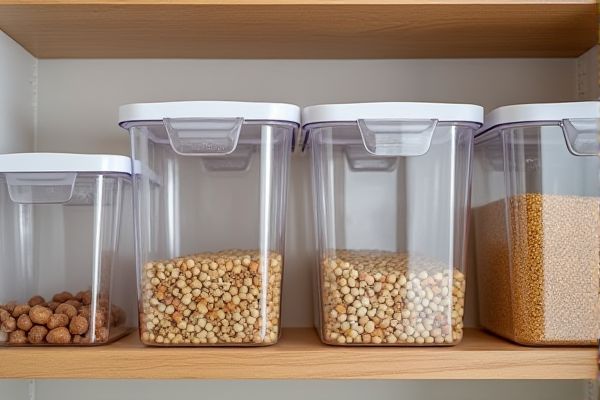
Acrylic bins offer clear visibility and a sleek, lightweight design ideal for organizing pantry items, while polycarbonate bins provide superior durability and impact resistance, making them perfect for heavy-duty storage needs. Discover which bin type best suits Your pantry organization by exploring the detailed comparison in the rest of the article.
Table of Comparison
| Feature | Acrylic Bins | Polycarbonate Bins |
|---|---|---|
| Material Strength | Moderate; prone to cracking under heavy impact | High; durable and impact-resistant |
| Clarity | Crystal clear, excellent transparency | Clear but slightly less transparent than acrylic |
| Weight | Lighter than polycarbonate | Heavier but offers better durability |
| Scratch Resistance | Moderate; prone to scratches | Higher scratch resistance |
| UV Resistance | Lower; may yellow over time | Better UV protection; resists yellowing |
| Cost | Generally more affordable | Higher price due to durability |
| Food Safety | Food-grade options available | Widely used for food storage; BPA-free options |
| Ease of Cleaning | Easy to clean but scratches may harbor bacteria | Easy to clean, more resistant to bacteria build-up |
| Usage in Pantry | Suitable for light to moderate use in pantry | Ideal for heavy-duty pantry storage needs |
Introduction to Pantry Storage Solutions
Acrylic bins offer clear visibility and a lightweight design, making it easy to organize and access your pantry items quickly. Polycarbonate bins provide superior durability and impact resistance, ideal for heavy-duty pantry storage that withstands frequent handling. Choosing between acrylic and polycarbonate bins depends on whether clarity or toughness is your primary priority in maintaining an efficient pantry.
What Are Acrylic Bins?
Acrylic bins are storage containers made from a clear plastic known for its glass-like transparency and high impact resistance, making them ideal for pantry organization. These bins offer a lightweight yet durable option that resists cracks and scratches, providing easy visibility of contents without opening. Their rigid structure and moisture resistance help maintain the freshness of dry goods and prevent spills during handling.
What Are Polycarbonate Bins?
Polycarbonate bins are durable, high-impact resistant containers made from a lightweight, transparent thermoplastic material commonly used for pantry storage. These bins withstand temperature variations and resist cracking, making them ideal for organizing food items while preserving visibility. Your pantry benefits from polycarbonate bins' clarity and strength, offering a long-lasting storage solution compared to acrylic alternatives.
Durability Comparison: Acrylic vs. Polycarbonate
Polycarbonate bins offer superior durability compared to acrylic bins, exhibiting higher impact resistance and less susceptibility to cracking or shattering under stress. Acrylic bins tend to be more prone to scratching and may crack over time with heavy use, making polycarbonate a better choice for long-lasting pantry storage. The enhanced toughness of polycarbonate ensures it withstands daily handling and accidental drops more effectively than acrylic.
Transparency and Aesthetic Appeal
Acrylic bins offer exceptional clarity with a glass-like transparency that enhances pantry organization by allowing easy visibility of contents. Polycarbonate bins, while slightly less clear, provide a more durable and impact-resistant option with a subtle matte finish that can reduce glare. Both materials elevate pantry aesthetics, but acrylic bins are often preferred for a sleek, modern look due to their superior optical clarity.
Weight and Handling Differences
Acrylic bins are generally lighter than polycarbonate bins, making them easier to handle and move around your pantry. Polycarbonate bins, though heavier, offer superior durability and impact resistance, ideal for long-term storage where sturdiness is essential. Choosing acrylic bins enhances lightweight convenience, while polycarbonate bins provide added strength and toughness for handling heavy or sharp items.
Safety and Food Compatibility
Acrylic bins offer excellent clarity and are food-safe, but they may crack or shatter under impact, posing a safety risk. Polycarbonate bins provide superior durability and resistance to breakage, making them safer for frequent use in your pantry. Both materials are BPA-free and non-toxic, ensuring compatibility with storing various food items without contamination.
Cost Considerations
Acrylic bins generally offer a more budget-friendly option for pantry storage compared to polycarbonate bins, making them suitable for cost-conscious consumers. Polycarbonate bins, while higher in price, provide superior durability and impact resistance, potentially reducing replacement costs over time. Investing in polycarbonate bins can be more economical long-term despite higher upfront costs due to their longevity and resistance to cracking.
Maintenance and Cleaning Tips
Acrylic bins require gentle cleaning with a soft cloth and mild soap to prevent scratches and maintain their clarity, while avoiding abrasive cleaners or rough sponges that can damage the surface. Polycarbonate bins offer higher resistance to impact and heat, allowing for more robust cleaning methods such as warm water and diluted bleach solutions without compromising durability. Both materials benefit from regular dusting and prompt removal of spills to ensure pantry organization remains hygienic and visually appealing.
Which Bin Is Best for Your Pantry Needs?
Acrylic bins offer clarity and a lightweight design ideal for easy handling and aesthetic appeal in pantry organization, while polycarbonate bins provide superior durability and impact resistance, making them better suited for heavy-duty use or homes with children. Acrylic is more prone to scratches and cracks over time but is often more affordable, whereas polycarbonate's robust structure maintains integrity under frequent use. Choosing the best bin depends on whether clarity and cost-efficiency or long-term durability and strength align more closely with your pantry's functional requirements.
 homyna.com
homyna.com